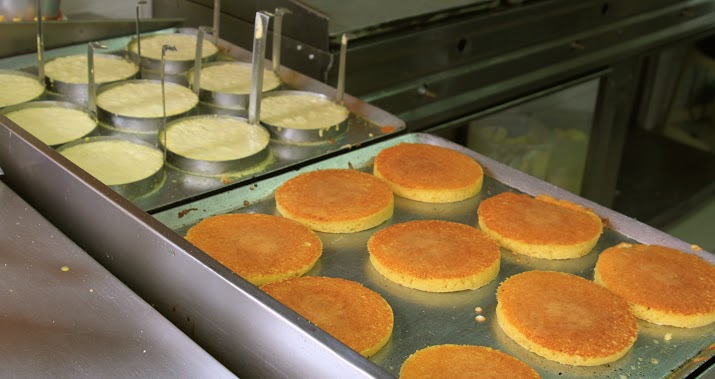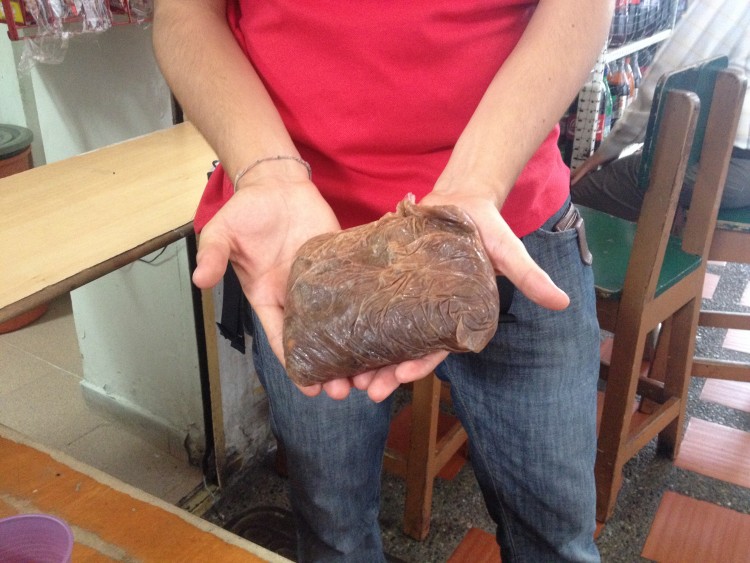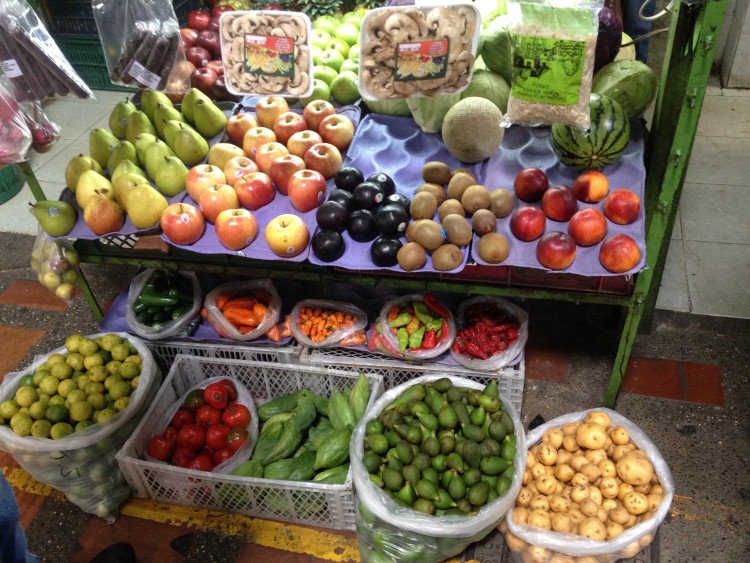I can’t remember ever going on a food tour before. I vaguely remember a winery tour in Argentina (it was good, I think), but that is about it.
So, the idea of walking around the streets of Envigado sampling different dishes sounded like a very pleasant way to spend a Wednesday afternoon.
Food is not the first thing that springs to mind when you think of Colombia, however many people love to learn about a country’s culture through its food.
The Colombian Street Food Tour by La Mesa began at 2 p.m. sharp with a meet and greet outside the pretty old church in Parque Envigado. I had already been very well briefed by a friendly and professional email advising me to bring an umbrella, sun cream and a jacket. Be prepared.
We were met by Juan Felipe, a friendly Colombian who was to be the tour leader for the next three hours. There was a small group of three of us from the U.S., Australia and the UK. La Mesa don’t do groups bigger than six to keep it intimate and manageable.
Juan Felipe began by giving us an intro into his life story. A former engineer who had lived in New Jersey (his English is very good) he now works for the renowned Carmen restaurant as well as guiding tourists for La Mesa.
He also gave us an introduction to the area with a brief history of Envigado. This was the first of many times that afternoon that I learnt something new about the place I have called home for the past year and a half.
Apparently there was a plaza with a food market behind the church – who knew? Not me evidently.
Juan Felipe started off by taking us 50 meters down the road for the first stop at a street vendor. For churros. A kind of donut. But less doughy. And I have to say tastier. We shared a packet between us.
A quick jaunt round the corner and we were at an arepa place. When I first tried the ground corn food, arepa, that so many Colombians feast on for breakfast I was bemused. It was bland and quite like cardboard.
Apparently I needed to put butter on it or add something to it. To you know, make it taste of something.
These bad boys on the other hand were made with sweet corn and topped with a tasty cheese. They were thicker and sweeter and all round just yummy.

We moved to an empanada store on the corner of the plaza. We learnt that the owners had founded it over 25 years ago, growing it substantially over the years, and were presently selling over 1,000 empanadas a day.
The empanadas were flavorsome. With a meaty, onion and potato core topped off with a hot chili sauce. Juan Felipe was doing a sterling job so far…

We walked back toward the church where we entered Plaza Envigado – the place I never knew existed. It is a winding food market with everything from fruit stalls to small restaurants, butchers to flower stalls.
We sat down next to a juice store and we were tested on our juice knowledge. I guessed the first one, tomate de arbol, a kind of sweet tomato juice.
The second one, I had not the foggiest. It tasted like soapy dirt. I kept sipping it and couldn’t decide for the life of me what it was. Or if I liked it. Or if I hated it.
The waitress brought over what looked like a bag of brown feces. Turns out it was a root of tree, borojo, with milk. Course it was!

With a mix of delicious exotic fruits including pitaya, grenadilla, and uchuva, the fruit choice is incredible in Colombia but there is a problem.
How do you open/eat them?
Juan Felipe gave us a briefing on what was to be peeled, threw away, chewed upon.
That was SO useful and only wish I had learnt that a while back..!

The fifth and penultimate place was to be Restaurante La Gloria de Gloria.
A place I had been before, where they serve delicious massive chicharrón (deep-fried pig skin) along side the typical Bandeja Paisa (a mix of rice, egg, avocado, beans, chorizo and pretty much everything carbtastic).
The charismatic owner, Gloria, can be known to wander around with a bottle of Aguardiente (known locally as guaro, a kind of strong licorice tasting alcoholic drink) and free pours as much as you can handle.
Alas, her doors were closed for what were unknown reasons. Juan Felipe, thinking on his feet, took us to another place to enjoy a Bandeja Paisa between us and explain about the history of why the locals needed the carb laden plate to work the fields.

We also sampled a refajo, a mix of the popular soft drink, Colombiana, and a beer. Apparently it is an excellent remedy for a hangover and was pretty tasty .
We then had one last stop back at the Plaza Envigado with a cheeky shot of Aguardiente and a farewell with a photo. End of tour!
Although the $45 per person won’t be for everybody’s budget, it can give those who live here a different glimpse of the place they call home. I would also recommend it as an ideal introduction for visitors interested in learning about Colombian culture and cuisine
Overall it was a highly enjoyable three hours tasting flavorsome food, learning about Colombian culture and enjoying pleasant conversation. The knowledge of how to open and eat the fruits was worth it alone.
La Mesa also do other food tours around Medellín and run the Colombian street food tour on Tuesdays, Thursdays and Saturdays, as well as being available for private tours upon request.
_________
My tour was provided compliments of La Mesa Food Tours.












Thanks for an informative article. I’ve been here for quite a while now, yet there were some foods on your list that I have not yet tried. I had never even heard of borojo.
I do want to offer a correction. Despite the widespread perception (even in Wikipedia), chicharrón is NOT deep fried pork skin. It is fried (not always deep fried) pork belly, the same thing from which bacon is made. Go to any meat counter, and look at the uncooked version before it is cut and you will see that it looks just like unsliced and uncooked bacon. The only difference is that for bacon, the pork belly is smoked before slicing. Granted, there might be a bit of skin along the edge (that’s the chewy bit), but you often find that in bacon too. It is true that the snack food that we from the USA call pork rinds and are also sometimes called chicharrón here are made from fried pig skin, but that is not what you get with bandeja paisa.
As for the arepa, I can’t tell you why, but I’ve gone completely 180 degrees on them. Like you, when I first arrived in Colombia, I just could not understand why anyone would eat that thin flavorless wafer and I found refuge in the arepa de chocolo (which in the USA, we would call a cornbread pancake). However, after being continually served the standard flat arepa despite my best efforts, I have come to love them. By themselves, they are not fun to eat. But with butter and a little salt, they are a great snack. As a base with toppings like mortadella con queso (bologna and cheese), they are fantastic. It is critical that they are cooked long enough to be very crisp; uncooked arepa is inedible. I knew I had gone over the edge when we went to a food court and I walked past all of the American-style restaurants (which used to be my salvation) to order arepa con quesito at a comida tipica restaurant.
Delightful article! Had the same first experience with arepa in a Colombian restaurant here in Denver; glad to know it can be better! Question about Chicharones…do people actually eat the hard part along the edge?
I have also taken a Street Food Tour with La Mesa in Envigado. I had a great experience and learned many things about Colombian food and culture from my tour guide, Nicole. Nick is dead-on about arepas, I really didn’t like most that I had tried before. Nicole brought us to the best places for arepas, empeñadas, and the fruit juices were the tastiest I have had since moving here late last year. I highly recommend this tour for the historical and cultural information, as well as the great food.
Wonderful article! Thanks for sharing your experience, Nick.
When traveling, I also love learning about a country’s culture through its food.
I tried Borojo juice for the first time a couple of months ago. The borojo fruit is truly unique and surprisingly rich in vitamins, minerals, amino acids and protein.
I would just like to point out that it is not a root- the fruit grows in a tree and ripens super quick, that’s why most of the type it’s in a bag.
How cold they not mention that Colombians claim that Borojo is an aphrodisiac!!!!